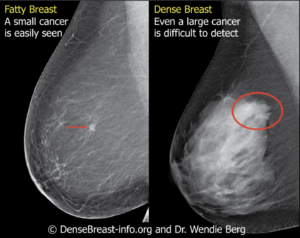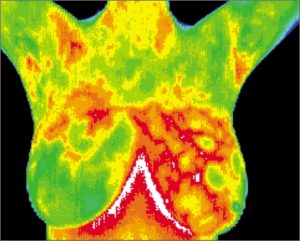You may have heard that having dense breasts means you have a higher risk of breast cancer. But is that actually true? The answer to that is a little complicated.
What is Dense Breast Syndrome?
First of all, what is Dense Breast Syndrome or Dense Breasts? It simply means that breasts have less fatty tissue and more non-fatty, glandular tissue and fibrous tissue.
According to the Breast Imaging Reporting and Database System (BI-RADS), there are four categories for breast density: *
- Mostly fatty or “normal.” About 10% of women have fatty breasts.
- Scattered fibroglandular density: The breasts are mostly fatty tissue, but there are a few areas of fibrous and glandular tissue visible on the mammogram. About 40% of women have scattered density
- Heterogeneously (consistent) density: Many areas of the breast contain fibrous and glandular tissue. About 40% of women fall in this category.
- Extremely dense: Breasts have mostly fibrous and glandular tissue. This accounts for the remaining 10% of women.
Women with a score of C or D are classified as having dense breasts. The radiologist interpreting the mammogram makes the classification, so it often requires a judgment call — and studies suggest that two radiologists may classify the same woman differently.
Is there a link between Dense Breasts and Breast Cancer?
BreastCancer.org[1] states that if you have dense breasts, your risk of developing breast cancer may be up to 6 times higher. And according to the National Cancer Institute, nearly 50% of all women age 40 and older have dense breasts. But don’t let those statistics scare you! Studies have not conclusively shown that dense breast tissue itself causes tumors or cancer to develop, however dense tissue can make it more difficult to detect tumors, especially through mammography alone. Fatty tissue appears dark on a mammogram, whereas dense tissue appears white. Breast tumors also appear as white on a mammogram. Dense breast tissue can mask the appearance of tumors. For women with extremely or mostly dense breasts, even large cancers can be difficult to detect.

This goes to show that mammography screening, often touted as the “gold-standard” in breast imaging, is an imperfect tool. Its limitations result in numerous recall screenings, unnecessary biopsies, and false positives. It also should be noted that mammography uses radiation to image the breast. While it is often stated that it is a “low dose,” no amount of radiation is considered “safe.” [2] In fact, new policies are being enacted by the American Cancer Society due to research[3] that shows the potential harms (and over diagnosis) that mammography can cause.
Be Informed and Proactive!
We are proud to offer not only one but two safe, non invasive complimentary breast screenings for women who are proactive about their breast health. Though no breast testing is 100% accurate, we believe a multi-modal approach is the most effective way to monitor your breast health.
Thermography:
Thermography is a test of function that detects inflammation and angiogenesis in the breast tissue (as well as other areas of the body), and studies have shown[4] that it can detect signs of cancer 5 years before it is seen on a mammogram. Since it is a test of function rather than a structural test, its effectiveness is not decreased by dense breast tissue and thus it is an excellent tool for women who have this condition. It has the added benefit of no radiation, no compression, and no pain.

Thermography image of dense breast tissue / fibrocystic activity
Ultrasound:
Screening ultrasound is a test of structure that uses sound waves and can detect abnormalities and cancer in women with dense breast tissue. Studies have shown [5] that ultrasound significantly increases detection of clinically important, small, largely invasive, node-negative cancers.

Breast cancer tumor appears black on an ultrasound and is easily visible.
[1]https://www.breastcancer.org/risk/factors/dense_breasts
[2] https://pubmed.ncbi.nlm.nih.gov/20582702/
[3 https://jamanetwork.com/journals/jama/fullarticle/2463262

